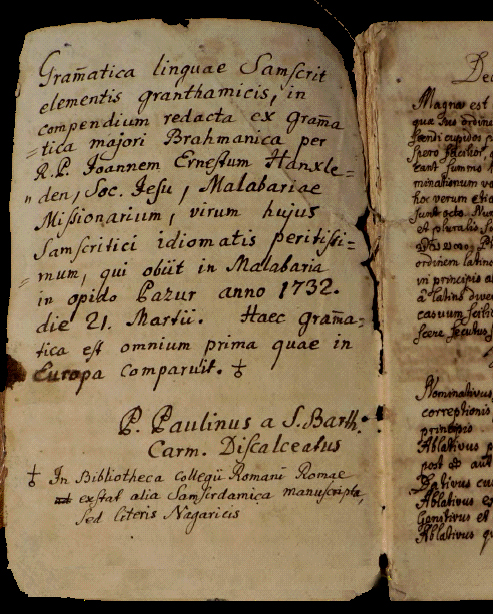
|
|
|
|
BY: SUN STAFF
 Nov 28, 2010 — CANADA (SUN) — A few months ago, a rare and important manuscript, the Grammatica Grandonica was rediscovered in an Italian monastery after having been lost for many decades. Authored in the early 1700's by the German Jesuit Johann Ernest Hanxleden, the Sanskrit grammer text was found by the Belgian scholar Toon Van Hal of the Center for the History of Linguistics, K.U. Leuven, the Katholieke University, Netherlands. Toon Van Hal rediscovered the lost manuscript by retracing the previous inquiries of Luxemburg scholar Jean-Claude Muller in and around Rome, uncovering it at the Convento di San Silvestro, a Carmelite monastery in Montecomprati, Lazio, Italy. Grammatica Grandonica is the earliest known missionary grammar on the Sanskrit language and had a great deal of influence on the emergence of the first published Sanskrit grammar ever printed in Europe, in 1790. This first published grammar, by the Carmelite missionary Paulinus a Sancto Bartholomaeo, is thought to have been taken directly from Hanxleden's original work. Jesuit Hanxleden in India Johann Ernst Hanxleden was born in 1681 near Osnabrück (Lower Saxony), Germany. From 1701 until his death in 1732, he served as a Jesuit missionary in Kerala, where he developed an expert command of the local Malayalam language. He also gained expertise in liturgical Sanskrit, which the local brahmans generally did not reveal to strangers. Hanxleden, however, had somehow convinced two brahmans to teach him the language, and he then wrote his Sanskrit grammar, Grammatica Grandonica, in order to share his knowledge with the western world. After studying philosophy in his hometown of Osnabruck, Hanxleden volunteered for missionary service in India. Along with two other Jesuits, Wilhelm Weber and Wilhelm Meyr, and Dr. Franz Kaspar Schillinger, the group traveled to India from Italy to Turkey, Syria, Armenia, and Persia, landing at Surat (Gujarat) on December 13th, 1700. During the journey, Hanxleden was formally ordained as a member of the Society of Jesuits. Weber and Meyr died at sea, and Hanxleden proceeded alone to Goa, where he joined a large community of Jesuits there. His work on the Grammatica was done in Goa, and he spent his later years at Palayur, Trichur district of Kerala. Father Hanxleden was the first to compile a written Malayalam dictionary, giving the Malayalam words in both Sanskrit and Portuguese. He then began his master work, the Grammatica Grandonica, which established him, along with his predecessor, Heinrich Roth, as one of the pioneering European Sanskrit scholars. Sanskrit only began to be seriously studied in the field of linguistics in Europe at the end of the 18th century, and the Grammatica Grandonica played a central role in drawing serious scholarly attention to Sanskrit from the European academics. Today, by the courtesy of the Carmelite Fathers of Convento di San Silvestro, the original Grammatica manuscript has been made available for download in PDF format.
| |